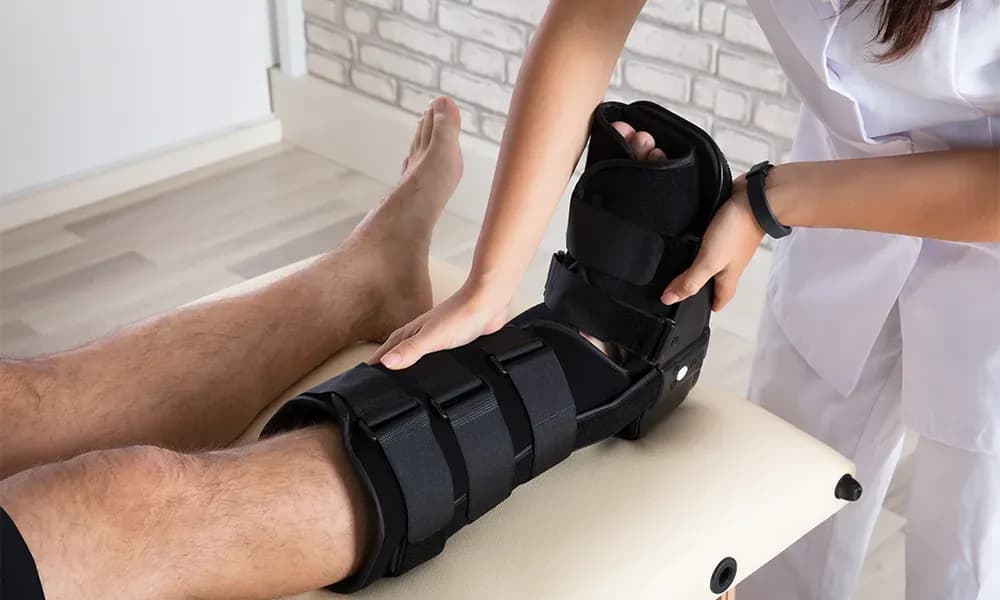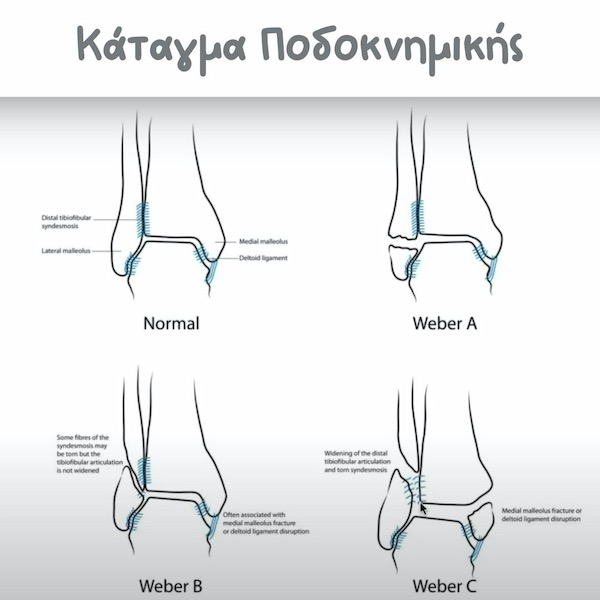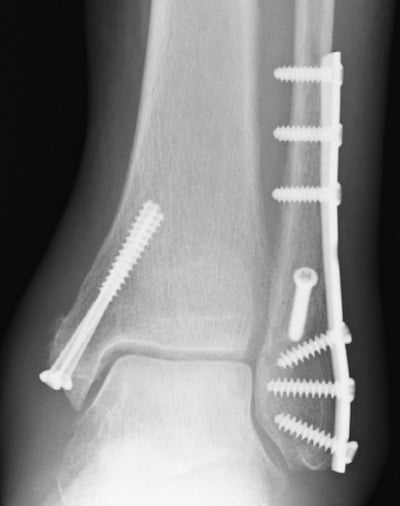Georgios Panagopoulos MD | Orthopaedic Surgeon

Table of contents
What is a broken ankle?
A broken ankle is a fracture (or fractures) of one or more of the 3 bones that make the ankle joint: the fibula, the tibia or the talus. The seriousness of the broken ankle can vary, from tiny cracks to very displaced bones that are sticking out of the skin.
Anatomy
The ankle joint consists of 3 bones that are held together with strong ligaments: the tibia, the fibula, and the talus (connects your leg to your foot). The ankle joint can break in more than one bone and the ligaments can often get damaged, as well. The ends of the tibia and fibula that make part of the ankle joint are called the malleoli (singular is “malleolus). The lateral malleolus is the distal end of the fibula (outside of the ankle) and the medial malleolus in the distal end of the tibia (inside of the ankle). The back side of the distal end of the tibia is also called posterior malleolus and is found at the back of the ankle. An isolated break of the lateral malleolus is very common and is often stable enough to be treated without surgery. A combined break of 2 or 3 malleoli (“bimal” or “trimal”), or an injury of a single malleolus with associated ligament injury (injury of the syndesmosis or deltoid ligament) is often unstable and may be treated with surgery.


What causes a broken ankle?
Ankle fractures may occur in any age and are among the most common injuries that an orthopaedic surgeon will treat. You may get a broken ankle from a twisting injury, such as a misstep on a curb or a fall off the stairs, or you may have a high energy direct blow, such as during a car accident.
You may be at high risk of getting a broken ankle if:
- You participate in high-energy sports that cause an increased stress on your ankle joint, such as football, basketball, gymnastics, etc.
- You do not use proper technique, or you use faulty or inappropriate equipment during sports.
- You suddenly boost your activities without proper training or warming up, i.e. you are a “weekend warrior”.
- You have underlying conditions that make bones weaker, like osteoporosis.
- You are a smoker
What are the symptoms of a broken ankle?
If you get a broken ankle, you may experience the following:
- Severe pain
- Bruising & swelling
- Inability to weight bear & walk
- Obvious deformity in severe cases
- Open fracture
How is a broken ankle diagnosed?
The doctor will take a complete history and perform a thorough physical exam with attention to not causing you further anxiety and pain. A simple x-ray is usually enough to initially diagnose a broken ankle upon clinical suspicion. It’s important for the doctor to get repeat x-rays after setting your ankle, as these will guide treatment and will confirm an appropriate position that will prevent severe swelling. A stress x-ray (weightbearing x-rays or against gravity) is sometimes needed to further assess a subtle injury or check for instability. Your surgeon may request a CT scan in complex cases for preoperative planning.
How is a broken ankle treated?
Ankle fractures are often very painful and may be accompanied by an obvious deformity if your ankle is out of place (dislocated ankle). The emergency room doctor will examine your foot and check your neurovascular status. If the ankle is dislocated, the doctor may need to reduce it, meaning to set it straight after some sort of sedation, so that you remain comfortable. Then your ankle will be put in a splint and repeat x-rays will be made to check its position. You will then be sent to an orthopaedic surgeon for further treatment.


The surgeon will typically assess your injury and radiographs and decide as to whether you have a stable injury that can be treated conservatively, or an unstable injury that will benefit from surgery. If the injury is stable and no surgery is needed, your ankle may be kept in a splint, or you may be given a walking boot for a few weeks. You may also use crutches for a few weeks as walking aids. This is commonly the case in simpler injuries, such as an isolated lateral malleolar fracture without deltoid injury, or an undisplaced medial malleolar fracture. These can be treated with early weight-bearing in a protective boot. Unstable fractures, such as “bimals”, “trimals”, or fractures with associated syndesmotic injuries are treated surgically, usually with a combination of plates and screws. Surgery may be delayed for 1-2 weeks, in case of severe swelling, as this poses less risk to your healing. More severe cases may require admission to the hospital and a temporizing procedure (external fixation), meaning an initial surgery with an external scaffold of sorts, until the swelling subsides.
After surgery, you may expect your leg to be in a splint or protective boot. You may expect a wound check and suture removal 2 weeks after surgery. Your doctor and physiotherapist will create a customized rehabilitation plan based on a case-to-case basis. Most ankle fractures heal well, but a minority may develop stiffness, post-traumatic arthritis and not regain the full, pre-injury range of motion, depending on the severity of the initial injury.
Dr Panagopoulos has extensive experience in orthopaedic trauma surgery, and will discuss with you all options during your visit in our office.
FAQs - Frequently Asked Questions
What is a broken ankle?
A broken ankle is a fracture (or fractures) of one or more of the 3 bones that make the ankle joint: the fibula, the tibia or the talus.
What are the malleoli?
The ends of the tibia and fibula that make part of the ankle joint are called the malleoli (singular is “malleolus). The lateral malleolus is the distal end of the fibula (outside of the ankle) and the medial malleolus in the distal end of the tibia (inside of the ankle). The back side of the distal end of the tibia is also called posterior malleolus and is found at the back of the ankle.
What are the different fracture types?
An isolated break of the lateral malleolus is very common and is often stable enough to be treated without surgery. A combined break of 2 or 3 malleoli (“bimal” or “trimal”), or an injury of a single malleolus with associated ligament injury (injury of the syndesmosis or deltoid ligament) is often unstable and may be treated with surgery.
What's the typical mechanism of injury?
Ankle fractures may occur in any age and are among the most common injuries that an orthopaedic surgeon will treat. You may get a broken ankle from a twisting injury, such as a misstep on a curb or a fall off the stairs, or you may have a high energy direct blow, such as during a car accident.
Is surgery always needed?
No. Stable fractures can be treated in a splint or protective boot and instructed to early weight-bear.
How is the fracture monitored?
Your doctor will typically request a weight bearing X-ray in a week, to confirm stability of the fracture.
When do I need surgery?
More complex fractures or syndesmotic injuries are unstable and require surgery.
Do I need a second procedure to remove the metalwork?
Metalwork does not have to be removed, unless symptomatic.
Find us
Book an appointment with us today
